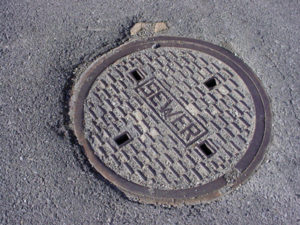What Are Sewer Overflows and Why Is Rainwater Management Crucial?
Sewer overflows are a very controversial topic in the Quebec province, due to their possible impact on lake and river eutrophication. A sewer overflow is a discharge of untreated or pre-treated water into the environment from a wastewater treatment facility. Such overflows occur for 2 main reasons; when the water processed by a facility exceeds its capacity (during heavy rainfall or snowmelt), or when a wastewater treatment facility undergoes major pipe renovations.
When a sewer system is said to be unitary (no separation between wastewater and runoff), the probability of sewer overflows is much higher during periods of heavy rain or snowmelt. Concrete surfaces in urban areas are impermeable, meaning that all the water falling on these surfaces immediately flows into the sewer system.

Since it is very expensive to build an oversized treatment plant that considers the maximum expected water flow, nearly the majority of municipalities in Quebec have a unitary network that is unable to contain the volume of water from heavy rains.
To avoid sewer backups, municipalities are reducing the hydraulic load on treatment plants by:
- Redirecting the excess water to upstream treatment plants through overflow points on the network, like pumping stations;
- Partially treating (pretreatment) this combined water and then discharging it into a running water body.
It is important to understand that this overflowing wastewater, in addition to being diluted by the abundance of rainwater, is pretreated, therefore reducing the environmental impact this pollution has on waterways. In the case of a planned overflow, decision makers try to choose the best possible timing. This timing is often during fall when dissolved oxygen levels in the water are their highest, also avoiding fish spawning periods. The authorities try to reduce the level of water in upstream retention ponds beforehand, to minimize the quantity of liter discharged in the environment.

In all cases, overflows are a last resort solution used by municipalities. Today, cities prioritize building separate sewage systems, i.e., networks with two different pipes (one for wastewater and the other for rainwater) which reduces the possibility of overloading the network during intense meteorological events in water supply. When a system is unitary, the municipality adopts specific standards for the management of water from permeable surfaces, discharge of water from roofs, and use of retention ponds to optimize system efficiency.
Being concerned about the quality of our waterways, we encourage you to learn about what is being done in your own municipality. You can certainly set up actions at a small scale to help prevent overflows!
To learn more about overflows: C.I. EAU – Water interpretation center
Here is an article we wrote on how we manage rainwater on Canadian Pond.ca’s property : Read the article